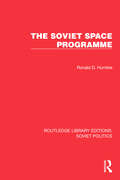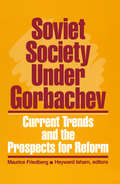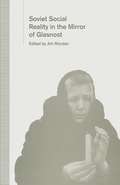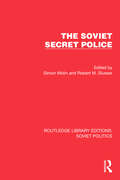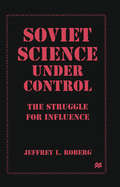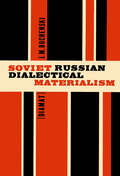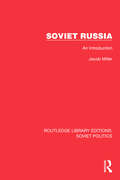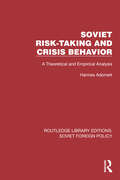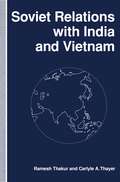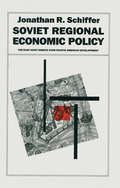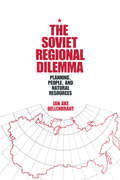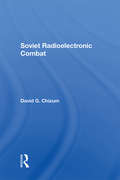- Table View
- List View
The Soviet Space Programme (Routledge Library Editions: Soviet Politics)
by Ronald D. HumbleThe Soviet Space Programme (1988) presents a comprehensive over-view of the Soviet space programme from its beginnings up to the end of the 1980s. One important theme explored is the degree to which the Soviet space programme was oriented towards military capabilities. The book concludes that the degree of military involvement was indeed high.
The Soviet Space Programme (Routledge Library Editions: Soviet Politics)
by Ronald D. HumbleThe Soviet Space Programme (1988) presents a comprehensive over-view of the Soviet space programme from its beginnings up to the end of the 1980s. One important theme explored is the degree to which the Soviet space programme was oriented towards military capabilities. The book concludes that the degree of military involvement was indeed high.
Soviet Society Under Perestroika
by David LaneThis is an up-to-the-minute revised edition of a text which, since its publication in 1990, has been extremely influential. The great changes of the past 18 months have entailed a comprehensive updating of the book. This edition takes account of new developments that include the independence of the Baltic states and the treaty which sparked 1991's attempted coup.
Soviet Society Under Perestroika
by David LaneThis is an up-to-the-minute revised edition of a text which, since its publication in 1990, has been extremely influential. The great changes of the past 18 months have entailed a comprehensive updating of the book. This edition takes account of new developments that include the independence of the Baltic states and the treaty which sparked 1991's attempted coup.
Soviet Society Under Gorbachev: Current Trends and the Prospects for Change
by Heyward Isham Maurice FriedbergThe essays in this volume assess key aspects of Soviet society and social policy under Gorbachev. It provides a survey of Soviet family problems and demographic change, economic and labour policy, the alcohol problem, nationality policy, and trends in culture and communications.
Soviet Society Under Gorbachev: Current Trends and the Prospects for Change
by Heyward Isham Maurice FriedbergThe essays in this volume assess key aspects of Soviet society and social policy under Gorbachev. It provides a survey of Soviet family problems and demographic change, economic and labour policy, the alcohol problem, nationality policy, and trends in culture and communications.
Soviet Socialism: Social and Political Essays (Routledge Library Editions: Soviet Politics)
by L.G. ChurchwardSoviet Socialism (1987) is based on the author’s specialized knowledge of many aspects of Soviet politics, including local government, the Communist Party and the Soviet intelligentsia. Written originally after the death of Brezhnev, in the Andropov-Chernenko interregnum, the essays were revised to take account of the accession to power of Mikhail Gorbachev, and they cover a selection of interrelated themes drawn from Soviet politics and society. The detached view the author takes of the Soviet state presents a new and stimulating approach to Soviet studies.
Soviet Socialism: Social and Political Essays (Routledge Library Editions: Soviet Politics)
by L.G. ChurchwardSoviet Socialism (1987) is based on the author’s specialized knowledge of many aspects of Soviet politics, including local government, the Communist Party and the Soviet intelligentsia. Written originally after the death of Brezhnev, in the Andropov-Chernenko interregnum, the essays were revised to take account of the accession to power of Mikhail Gorbachev, and they cover a selection of interrelated themes drawn from Soviet politics and society. The detached view the author takes of the Soviet state presents a new and stimulating approach to Soviet studies.
Soviet Social Reality in the Mirror of Glasnost
by Jim RiordanSoviet and Western sociologists come together in this book to present results of recent sociological surveys and to analyse important social issues against the background of the revelations of the late 1980s and early 1990s. The book spans six major issues: the family and women, social care, young people, deviance (including prostitution), leisure and privilege (including the black market).
The Soviet Secret Police (Routledge Library Editions: Soviet Politics)
by Simon WolinThe Soviet Secret Police (1957) depicts the main aspects of the development, structure and functions of the secret police of the Soviet Union. Much of the information contained within comes from the personal testimony of Soviet citizens who had experienced various activities of the secret police, and forms a full and objective study of the secret police and its role in the Soviet system.
The Soviet Secret Police (Routledge Library Editions: Soviet Politics)
by Simon Wolin Robert M. SlusserThe Soviet Secret Police (1957) depicts the main aspects of the development, structure and functions of the secret police of the Soviet Union. Much of the information contained within comes from the personal testimony of Soviet citizens who had experienced various activities of the secret police, and forms a full and objective study of the secret police and its role in the Soviet system.
Soviet Science under Control: The Struggle for Influence
by Jeffrey L. RobergRoberg examines the relationship between the political leadership of the Soviet Union and Soviet science. Previously, this relationship was typically characterized as one of Communist Party dominance over the sciences. He argues that the relationship between scientists and the leadership is better viewed as bi-directional. The author concludes that scientists had an influence on policy-makers in the areas of nuclear policy and human rights although not to the same degree as the Party had on science and scientists.
Soviet Russian Dialectical Materialism [Diamat]
by J. M. BochenskiThis book offers a critical outline of the sources of the history, of the spirit and of the doctrines of present-day Soviet Russian Dialectical Materialism ('Diamat'), i.e. of the philosophical foundations of Marxism Leninism. It is scarcely necessary to stress the usefulness of a short outline of this kind, as Russian sources are not easily accessible in the West and as it is of considerable interest to know the doctrines which make up the faith of the Communists* in all countries. The material for this book was first made public in a series of lectures at the University of Fribourg (Switzerland), first in French in the summer term of 1949, later in English at the Summer School in the same year. The French text, slightly expanded, was translated into German by Miss M. Hoerkens, Dipl. rer. pol. Various imperfections in the wording of the text and in the bibliography can be explained by the process of formation of this book. The author hopes that such imperfections will not prove disturbing.
Soviet Russia: An Introduction (Routledge Library Editions: Soviet Politics)
by Jacob MillerSoviet Russia (1955) discusses the origins and growth of Russian industry, in particular the emergence of a large modern working class and administrative class since the war, how the factories and farms are run, the wage systems, and the plans. The development of farming is described, especially the political management of relations between the peasants and industry. It covers the Soviet political system as a product of Russian history, and the deep changes in the Soviet political system after industrialization. It also looks at finance, the standard of living, strikes, the control of labour, family organization, ideas of world revolution, and the nations of the Soviet Union.
Soviet Russia: An Introduction (Routledge Library Editions: Soviet Politics)
by Jacob MillerSoviet Russia (1955) discusses the origins and growth of Russian industry, in particular the emergence of a large modern working class and administrative class since the war, how the factories and farms are run, the wage systems, and the plans. The development of farming is described, especially the political management of relations between the peasants and industry. It covers the Soviet political system as a product of Russian history, and the deep changes in the Soviet political system after industrialization. It also looks at finance, the standard of living, strikes, the control of labour, family organization, ideas of world revolution, and the nations of the Soviet Union.
Soviet Risk-Taking and Crisis Behavior: A Theoretical and Empirical Analysis (Routledge Library Editions: Soviet Foreign Policy #15)
by Hannes AdomeitSoviet Risk-Taking and Crisis Behavior, first published in 1982, examines the question: for what purposes and under what conditions were Soviet leaders prepared to take risks in international relations? The first part of the book sets out to define the concept of risk and to examine its analytical relevance for foreign policy, its measurement and its relation to the dynamics of crisis. The second part consists of in-depth analysis of Soviet behavior in the Berlin crises of 1948 and 1961. The third and last part compares Soviet policy in the two crises, and the actions of the two different leaderships, as well as relating it to Soviet behavior in other geographical areas.
Soviet Risk-Taking and Crisis Behavior: A Theoretical and Empirical Analysis (Routledge Library Editions: Soviet Foreign Policy #15)
by Hannes AdomeitSoviet Risk-Taking and Crisis Behavior, first published in 1982, examines the question: for what purposes and under what conditions were Soviet leaders prepared to take risks in international relations? The first part of the book sets out to define the concept of risk and to examine its analytical relevance for foreign policy, its measurement and its relation to the dynamics of crisis. The second part consists of in-depth analysis of Soviet behavior in the Berlin crises of 1948 and 1961. The third and last part compares Soviet policy in the two crises, and the actions of the two different leaderships, as well as relating it to Soviet behavior in other geographical areas.
Soviet Relations with India and Vietnam
by Ramesh Thakur Carlyle A. ThayerIndia and Vietnam have been two foci of Soviet diplomacy in Asia. This book examines the relations between India, as a poor parliamentary democracy, and the USSR and relations with Vietnam help demonstrate the relationship between the USSR and an Asian communist power.
Soviet Regional Economic Policy: The East-West Debate Over Pacific Siberian Development (Studies in Russian and East European History and Society)
by Jonathan R. SchifferAn analysis of Soviet spatial resource allocation decision making during the period 1955-1980, utilizing a political economy framework to evaluate the "East-West" debate over relative investment shares in the European and Pacific Siberian parts of the USSR. It has case studies and trade details.
The Soviet Regional Dilemma
by Jan Ake DellenbrantIncorporating an oral history approach, this history of radio covers the impact of the arrival of television, the rise of transistor radios, the popularity of rock n' roll, FM stereo stations, underground radio of the sixties, talk radio, public radio, and how technology will affect its future.
The Soviet Regional Dilemma
by Jan Ake DellenbrantIncorporating an oral history approach, this history of radio covers the impact of the arrival of television, the rise of transistor radios, the popularity of rock n' roll, FM stereo stations, underground radio of the sixties, talk radio, public radio, and how technology will affect its future.
Soviet Reforms and Beyond
by Leo CooperSince Gorbachev came to power much has happened in the Soviet Union. This book provides a comprehensive and composite analysis of the reforms that have taken place in the Soviet Union since 1985.
Soviet Radioelectronic Combat
by David ChizumRadioelectronic combat (REC) embraces the entire range of possibilities for manipulating the electromagnetic spectrum to military advantage. Options include electronic warfare, physical destruction of electronic targets, signals intelligence, and radio-electronic concealment and deception. Developed in the early 1970s by the Soviets, it is still poorly understood in the West. This study analyzes REC as a method of warfare with which Western military thinkers must reckon seriously at all levels of combat planning. It also provides a solid base of information on REC's origins, functional structure, and basic military goals. Equally important, it defines REC's greatest threat as conceptual rather than technological. Manipulating the electromagnetic spectrum depends more on thoughtful planning and centralized control than on sophisticated equipment¡ further, the Soviets appear to be ahead of the West in integrating the concept as an institutional part of military activity. Based primarily on Soviet sources, this book not only traces the evolution of REC but also serves as a model for understanding the development of other Soviet combat concepts.
Soviet Radioelectronic Combat
by David ChizumRadioelectronic combat (REC) embraces the entire range of possibilities for manipulating the electromagnetic spectrum to military advantage. Options include electronic warfare, physical destruction of electronic targets, signals intelligence, and radio-electronic concealment and deception. Developed in the early 1970s by the Soviets, it is still poorly understood in the West. This study analyzes REC as a method of warfare with which Western military thinkers must reckon seriously at all levels of combat planning. It also provides a solid base of information on REC's origins, functional structure, and basic military goals. Equally important, it defines REC's greatest threat as conceptual rather than technological. Manipulating the electromagnetic spectrum depends more on thoughtful planning and centralized control than on sophisticated equipment¡ further, the Soviets appear to be ahead of the West in integrating the concept as an institutional part of military activity. Based primarily on Soviet sources, this book not only traces the evolution of REC but also serves as a model for understanding the development of other Soviet combat concepts.
